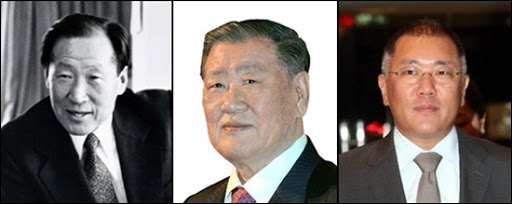
Though founded in 1967, Hyundai Motor’s origins date back to 1940s, when entrepreneur named Chung Ju-yung established Hyundai Auto Service in Seoul after Korea was liberated from Japanese colonial rule in 1946.
Along with the Hyundai Auto Service, Chung established Hyundai Engineering and Construction in 1947 to help South Korea rebuild and industrialize after the liberation.
However, the Korean War broke out in 1950, forcing Chung to abandon his businesses in Seoul and evacuate to Busan. During the war, Chung grew his construction business by winning orders from the US military stationed in Korea. After the war, Chung further focused on the construction business to rebuild South Korea from the ashes.
After a long wait, a chance finally came for Chung to restart his auto business, as late President Park Chung-hee introduced the Second Five Year Economic Plan in 1967 to expand social infrastructure and roll out highways. For the plan to succeed, the localization of cars was crucial.
In the same year, Chung founded Hyundai Motor, which started as a joint company with Ford. The partnership with the established automaker offered an invaluable opportunity for Hyundai Motor to learn about producing automobiles.
In May 1968, Hyundai Motor began the construction of a manufacturing plant in Ulsan with an annual capacity of 5,000 cars. In November, Hyundai Motor began the production of its very first model, the Cortina, which was made with 21 percent Korean-made parts.
As the Korean government aimed to spur economic growth by underwriting the production of Korean-designed vehicles, Hyundai hired Italian designer Giorgio Giugiaro and British engineers to develop the Pony, Korea’s very first mass-produced car released in 1976, which was powered by a Mitsubishi inline four-cylinder engine.
Pony proved to be an export success in Europe and South America, but fell short of breaking into the premium US market. Since then, to satisfy the standard of US customers, Hyundai concentrated on quality and introduced the Excel in 1985.
Hyundai Motor introduced the Excel to the US market in two types: a 4-door sedan and a 5-door hatchback. The Excel recorded first-year exports of 168,882 worldwide, proving the company’s mettle as a new contender on the global stage.
In 1990s, Hyundai became a truly independent automaker by breaking free from Mitsubishi’s engine designs. In 1991, Hyundai Motor unveiled the Scoupe -- a coupe version of the Excel -- with its first all-Korean engine, Alpha.
Today’s Hyundai Motor took shape during the 1997-1998 Asian financial crisis, when Hyundai Motor acquired the struggling Kia Motors in 1998. In 2000, Hyundai Motor and nine other affiliates separated from Hyundai Group to form Hyundai Motor Group with Chung Mong-koo, son of founder Chung Ju-yung, taking the post of chairman.
Since then, Hyundai Motor Group has made relentless efforts to upgrade its own engines, boost quality control efforts and enter the high-end market, exemplified by its luxury brand Genesis, which was launched in 2015.
In 2009, Chung Mong-koo’s son Chung Euisun was appointed as Hyundai Motor Group vice chairman. In 2018, Chung Euisun was promoted to executive vice chairman. Serving as the de-facto leader of Hyundai Motor Group for two years, Chung Euisun succeeded his father on Wednesday at a time when global auto firms face strong challenges from new players such as Tesla.
By Kim Byung-wook (kbw@heraldcorp.com)



















![[Today’s K-pop] BTS pop-up event to come to Seoul](http://res.heraldm.com/phpwas/restmb_idxmake.php?idx=642&simg=/content/image/2024/04/17/20240417050734_0.jpg&u=)